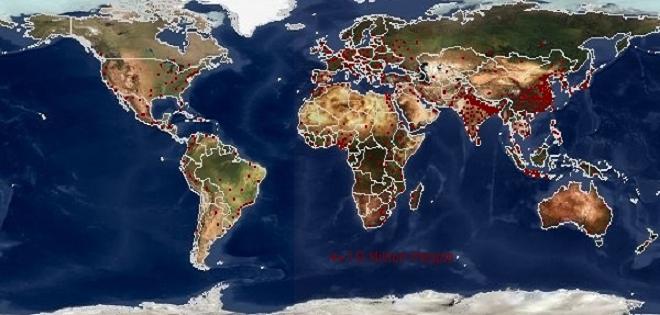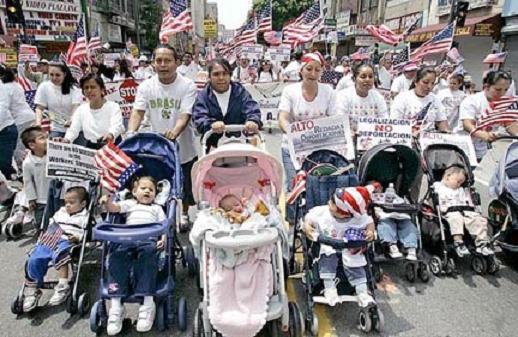The Thermodynamics of Conservatives and Liberals
The Biogeography of Political-Religious Affiliation
by Charles Brack

What principles of biogeography are conservatives and liberals following?
When it is all said and done, the modern study of political and religious disposition will owe much to the study of biogeography, and two shining stars of sociobiology, Robert MacArthur and Edward Wilson. In 1967, MacArthur and Wilson (M&W) published The Theory of Island Biogeography, which outlined the theory of r-K selection, and ultimately, the survivability of species.
The Theory of Island Biogeography is a theory of species population distribution. There are major evolutionary implications in the ability of a species to distribute itself across space and time, not to mention the curious thermodynamics associated with this distribution. That is, species that can modulate their thermodynamic properties in response to environmental changes dramatically increase their probability of survival. In humans, there is no better example of thermodynamic modulation than conservatism and liberalism.
One of the more prominent biogeographic variations between conservatives and liberals is population density. The conservative-liberal asymmetries in population density are easily seen in the voting patterns of urban, suburban, and rural environments. As a general rule, the greater the population density, the more liberal the population. In the 2004 US Presidential Election, the Democratic candidate, John Kerry, won every city with a population over 500,000. This same pattern was repeated in 2008 with Barack Obama.
The mystical and long-standing relationship between liberalism and urbanism is common across all cultures, and raises several interesting questions: is this a self-selection process, whereby the conservatives flee to the suburbs leaving the big cities to the liberals; or, does urban life liberalize people? There is certainly much evidence for the self-selection effect, but we also believe that high-density living tends to liberalize people, although the evidence is less clear.
The Politics of Species Survival
But for now, let's take a closer look at what the scientific discipline of population biology may be telling us about conservatives and liberals. The survival of any sexually reproducing species is highly dependent on maintaining a reproductively-effective population density. A very sparse population has problems maintaining reproduction, especially genetically-diverse reproduction. On the other hand, a very dense population has problems with habitat depletion and contamination.
Human habitat range: the greater the range, the greater the probability of species survival
In their groundbreaking study of island biogeography, M&W noted some interesting trends that apply directly to the study of political-religious disposition. First, a species that is able to establish populations on more than one island in an archipelago greatly reduces the risk of extinction. At first blush, this seems to be irrelevant to the study of conservatives and liberals. However, it is founded upon two behaviors that improve species viability: the ability to increase habitat range; and the ability to create genetic diversity. In other words, increase the habitat and genetic ranges, and increase the survival probability of a species, not to mention the acceleration in the rate of evolutionary change. From our information gathered so far, we believe that conservatives increase habitat range to a greater extent than liberals, and liberals increase genetic diversity to a greater extent than conservatives. Interestingly, conservatives and liberals, at opposite ends of the political spectrum, seem to be at the center of the survivability of the human species.
Second, M&W noted that island area varies directly with the number of species. The application of this biogeographic tendency to conservatives and liberals is a bit tenuous, since conservatives and liberals are part of the same species. However, there is a good reason to believe that geographic area and habitat variation contribute substantially to genetic variation within the same species. From this, one can argue that geographic area and habitat variation induce greater variations in political-religious orientation, and indeed, there seems to be evidence for this. On average, the greater the genetic variation and territory separating two populations, the greater their political and religious differences.
Third, cohesiveness is necessary for the survival of new colonists. This cross-species phenomenon noted by M&W is best observed among humans in the very religious. Their social cohesiveness and elevated reproductive rates are no coincidence. In new territories, social cohesion improves reproduction, equitable resource distribution, defense, and the survival of small breeding populations, which is why the history of emigration so prominently features coordinated religious emigration. Indeed, this is corroborated by the Sosis and Bressler study of 83 religious and secular communes, which found that the mean longevity of religious communes was 35.6 years, while secular communes lasted an average of 7.7 years. As we have mentioned before, the behavioral coordination of the religious conservatives is remarkable. This tendency of animal social behavior is phylogenetically ancient, and among mammals, reaches its pinnacle in humans.
Fourth, the average survival time of a founding population increases exponentially with r. r is the rate of population growth if resources are not an issue. That is, if there are no resource constraints, r is the growth rate of a population. A species with a high r improves its survivability dramatically. Essentially, a species that can rapidly convert the potential energy of an environment into reproduction will be successful, as long as the environment cooperates. Once the environment stops cooperating, time to bring in the liberals.
From M&W's findings with other species, one can presume the survival time of human colonies is also exponentially increased by population growth, be it from reproduction or immigration. The strong orientation of the religious conservatives against abortion and gay marriage is an echo of the evolutionary pressure for species to convert the potential energy of an environment into reproduction, countering the tendency for quick extinctions of small populations. Thermodynamically speaking, conservatives seem to run hotter than liberals.
Fifth, in an environment with no crowding, genotypes that can harvest the most food will have the most offspring; in crowded areas, genotypes that can reproduce with the lowest amount of food will displace less efficient forms of reproduction. The human equivalent of these diverse biogeographic tendencies is conservatism and liberalism. The thermodynamics of reproduction vary quite a bit across political-religious affiliation, with conservatives doing a good job at increasing the amount of energy an environment devotes to reproduction. When conservatives enter a habitat, they quickly divert its potential energy into reproduction, so there is a net increase in the human biomass. The liberals do a better job at maintaining human biomass in an equilibrium state with the environment, that is, they modulate reproduction up and down quickly to match the available energy. This difference is seen in the divergent attitudes on environmental issues.
Populations that utilize less energy in reproduction tend to displace populations that use more
Sixth, M&W noted that fast-dispersing species are usually displaced as competitor species infiltrate the island. This tendency is of considerable interest in its potential application to conservatives and liberals, for several reasons. First, while M&W formulated this at the species level, it appears to be operable within the same species. Are conservatives easier to displace by competitors than liberals? This is a complicated issue, but in general, in the absence of warfare, this seems to be true. Curiously, warfare has a greater chance of improving conservative reproduction and ruining liberal reproduction, at least among Caucasians.
Seventh, a new colonizing species favoring r selection will tend to change back to K selection. The applicability of this phenomenon to human behavior is certainly of great interest, as history is replete with examples of the rise and fall of empires. The key question is, why does a species, increasing in population density, begin to favor slower reproductive rates?
This phenomenon is curious, in that it occurs in most species, and for many diverse reasons. In plants, such as rice, molecules are secreted that inhibit the growth of other plants. For animals, biological cues such as odor induce reductions in reproduction, although other checks on population growth include resource depletion, competition, predation, disease, cannibalism, and stress.
Interestingly, the highest rates of fertility are not necessarily found where population densities are very low. Across many species, the highest rates of fertility are found near one-half the carrying capacity of a habitat. For example, if a habitat can hold 1,000 individuals, the highest fertility rates are found somewhere around 500, after which point, fertility rates start to decline.
If resource depletion is the limiting factor on population growth, it usually impacts the duration of the sexual maturation process, fertility rates, and mortality rates. This is related to the phenomenon of conservation of biomass, that is, the total biological mass of a population. Biomass tends to increase until one or more limiting resources becomes exhausted, at which point, no further increases can occur. However, population growth can continue, as long as average body mass declines, thus conserving total biomass.
This interesting state of a population, whereby no further increases of biomass are possible, is called K. K is the equilibrium limit of a population in a given habitat over a given time period. The pressure of a population to move towards K-selection involves three major causes: resource scarcity, environmental contamination, and population density response. Based on our survey evidence, when is comes to reproduction, resource scarcity (i.e., financial incapacity), impacts moderates and conservatives more than liberals. The liberals seem to be more likely to voluntarily reduce their reproductive rates in the face of environmental issues and crowding, long before the conservatives take notice.
The liberals are an early warning system for population control, as their behavior reduces the tendency for populations to crash and become extinct. As populations approach K, they will often exceed it, however briefly. When K is exceeded, and the population does not react quickly enough to reduce habitat load, populations can crash violently. The greater the delay in responding to the population overload, the more violently the population will crash, often leading to extinction.
To conservatives, the environmentally fanatical behavior of liberals is indeed curious, not to mention an affront to their greater propensity for reproduction. But indeed, the evolutionary pressure for environmentalism is extreme. Large urban populations are full of liberals, as seen in the voting patterns of large cities.
But the conservatives also contribute, primarily by their absence, to the successful regulation of urban populations. The distaste that conservatives have for urban life is one of the strongest tendencies we have noted in our research, and this aversion seems to be associated with their elevated propensity for reproduction. This behavior also has phylogenetically ancient roots.
When it comes to population density and dispersal, rodent studies have led to some interesting proposals that are directly applicable to human behavior. In particular, Lidicker and Eisenberg noted that the lower the equilibrium density of a population, the sooner the individuals exhibit some sort of population density response: that is, they begin to emigrate or engage in territorial behaviors. Second, these responses are greater in r-selected than in K-selected species.
This follows the patterns we have observed in conservatives. Conservatives tend reproduce at a younger age, have more children, emigrate to lower density environments (i.e., the suburbs), and seek less genetic variation in their mating partners and habitats in general. As such, they are more likely to respond negatively to high population densities.
Thus, self-selection away from high-density environments is a prominent feature of religious-conservatism, and not surprisingly, the religious-conservatives have a greater tendency towards behavioral coordination within small groups. This follows the general human tendency: the greater the religiosity in a population, the higher the reproductive rates. The high degree of behavioral coordination exhibited by religious migrations has parallels with many other mass-migrating species.
The tendency for liberals and conservatives to segregate based on population density leads to the following general rule: conservatives and liberals distribute asymmetrically across geographic area. The clustering of liberals in the urban regions offers a measure of segregation from the suburban and rural preferences of conservatives.
Geographically, conservatives and liberals tend to stay out of each other's way, certainly more so than any other political cohorts. The big payoff with all this activity is something quite remarkable: the development of liberal-conservative habitat corridors. The concept of a habitat corridor is borrowed from population ecology, where two habitats, connected by an easy mode of travel, increase both the number and survivability of species in both habitats.
Orange County, California: the high-energy model of Caucasian reproduction on full display
In humans, this is best illustrated by urban sprawl, which is a continual process of building suburbs on the expanding borders of cities. This not only requires a substantial initial investment of energy, but a corresponding elevation in energy utilization per person in the new suburbs. In humans, as in other species, energy flows rapidly into reproduction, and the urban habitat corridor to the suburbs facilitates this process.
Thus, the liberal tendencies of urban populations and the conservative tendencies of suburban populations support two diverse modes of energy utilization in reproduction, which collectively increases the long-term reproductive capacity and occupied area of a population. Few things support the long-term reproductive capacity of a population better than an appropriate mixture of conservatives and liberals, as the conservatives optimize reproduction across space, and the liberals optimize it across time.
The ability for liberals to reduce birth rates and the energy required for reproduction extends existing habitat life and supports large, dense populations. The propensity for conservatives to seek out new habitats and make them suitable for reproduction relieves pressure on urban areas, and further, performs one of the major tasks in improving the survivability of a species: extending the total inhabited area.
One of the more interesting findings of M&W, and one with major human implications, was the tendency for a colony, once established, to slide back to the mean r of the mother population. That is, it transforms from the rapid reproductive strategy of r-selection and back to the more deliberate reproduction of the population it originated from.
This tendency, as applied to humans, has yet to be studied. However, it is reasonable to assume this to be true, given the tendency for those individuals oriented towards high reproductive rates to emigrate away from K populations. We also cannot discount environmental or epigenetic processes that might be contributing to this curious phenomenon.
MacArthur and Wilson also noted that species tend to lose dispersal power when the value of dispersal power is low. For example, winged insects will lose the capacity for flight when the opportunity or necessity for dispersal is low. Specialized populations also tend to lose the power to colonize. The longer a population spends in a given habitat, the more specialized it becomes, and the more difficulty it has with emigration to different habitats. Liberalism and specialization are highly correlated, which is ultimately founded upon high-density lifestyles and the greater pressure on finding or creating new niches.
Discussion
The proposal that conservatives run "hotter" than liberals, that is, they burn more energy, is ultimately founded upon their higher reproductive rates. From the perspective of species survival, conservatives seem to be performing the important function of the rapid conversion of the potential energy of an environment into reproduction, that is, human biomass. Conservatives extend habitat range to a greater extent than liberals, exploiting environments that ultimately increase the conversion of potential energy into children.
Liberals do a much better job at the other major behavior associated with species survival, which is the ability to rapidly modulate their thermodynamic properties to match the available energy of a given habitat. Over time, in a given territory, they seem to be able to maintain a higher average level of human biomass than conservatives. Ironically, the asymmetric geographic distribution of conservatives and liberals are connected via habitat corridors, which seem to be assisting both the conservative-suburban and the liberal-urban modes of reproduction.
The geographic segregation of conservatives and liberals is actually a more efficient model of total reproduction than a symmetric distribution of these two adversaries. Unfortunately, geographic segregation seems to exacerbate their tendency for political conflict at the national level, while reducing it at the local level.
Charles Brack, January, 2009
References:
P. Arcese and J. Smith (1988) Effects of population density and supplemental food on reproduction in song sparrows. Journal of Animal Ecology 57: 119:136.
A. Brooks (2006) Who Really Cares: The Surprising Truth About Compassionate Conservatism. Basic Books, New York.
T. Carsey (1995) The Contextual Effects of Race on White Voter Behavior: The 1989 New York Mayoral Election. The Journal of Politics. Vol. 57, No. 1 (Feb 1995) pp. 221:228.
K. Cox (2005) Suburbia and Voting Behavior in the London Metropolitan Area. Annals of the Association of America Geographers. Vol. 58, Issue 1, p. 111:127.
R. Eisenberg (1966) The regulation of density in a natural population of the pond snail Lymnaea elodes. Ecology, 47(6):889:906
C. Fowler (1981) Density dependence as related to life history strategy. Ecology 62: 602-610.
W. Lidicker (1965) Comparative study of density regulation in confined populations of four species of rodents. Researches on Population Ecology 7(2): 57:72.
R. MacArthur and E. Wilson (1967) The Theory of Island Biogeography. Princeton, NJ: Princeton University Press.
E. Matthysen (2005) Density-dependent dispersal in birds and mammals. Ecography Vol. 28, Issue 3, pp. 403-416.
D. McCullough (1982) Population dynamics of the Yellowstone Grizzly. Dynamics of Large Mammal Populations. p. 173-196 Wiley. New York.
D. Smith and S. Cooper (1982) Competition among Cladocera. Ecology 63: 1004:1015.
R. Sosis and E. Bressler. (2003) Cooperation and Commune Longevity: A Test of the Costly Signaling Theory of Religion. Cross-Cultural Research. May 2003. Vol 37, No. 2, p.211-39.
P. Turchin (2003) Historical Dynamics: Why States Rise and Fall. Princeton University Press, Princeton, New Jersey.
Charles Brack



